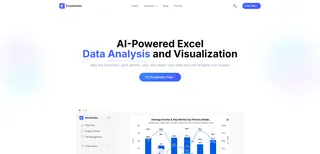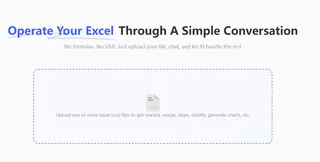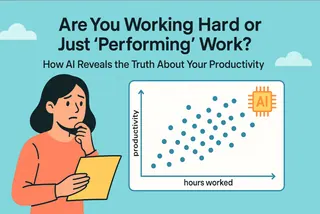- You're seeing business growth, yet new ideas are becoming rare and your company's competitive edge is eroding.
- Leadership dashboards show isolated metrics, failing to connect the pace of execution with a decline in creativity.
- Analytics platforms like Excelmatic bridge these data silos, turning a leader's intuition into visual evidence.
- The value is to move beyond delivery metrics and quantify how burnout culture impacts innovation, enabling you to make decisions that protect your company's future.
The CEO's Paradox: When High Performance Doesn't Equal Innovation
As a leader, you're looking at the quarterly dashboard: revenue is up, project velocity is high, and your teams are logging more hours. On the surface, the performance metrics look good.
But a question looms in your mind: Where is our next breakthrough product?
You notice that while everyone is rowing harder, no one has time to look at the horizon. The pipeline for new ideas is slowing down. Product updates are incremental, not inventive. The corporate engine is running, but it's losing its ability to navigate new territory.
You have a gut feeling that the pace of work and the "always-on" culture, while delivering today's results, might be suffocating tomorrow's growth. But when you raise this in a board meeting, you realize you have no data to back up this strategic intuition.
The Blind Spot: Why Data Silos Hide the Cost of Burnout
Why is this trend hard to spot? Because in most organizations, the full story is fractured across disconnected data silos:
- Your HR dashboard shows: “Engineering team’s average logged hours increased by 20% this quarter.” — This is an input metric.
- Your Project Management (PMO) report shows: “98% of all key initiatives were delivered on time.” — This is an execution metric.
- Your Product team’s data might show: “New feature proposals from the team have declined by 30%,” or “Our Product NPS has started to trend down.” — This is a value metric.
Each report, on its own, tells a piece of the truth. But the connection between them remains invisible. No tool makes it easy to merge these points and answer the fundamental question: Are our long hours creating long-term value, or just consuming our future?
An AI Solution to Connect Burnout Metrics with Business KPIs
This is the core value that AI analytics tools like Excelmatic bring to leadership. It's not just a charting tool; it's a strategic hypothesis-testing engine.

Excelmatic connects data across departments, allowing you to view your organization from a new perspective:
- Fuse Disparate Data Sources: Combine HR’s time-tracking data, the PMO’s delivery stats, and the product team’s innovation metrics into a single analysis.
- Ask Strategic Questions in Plain English: You don't need to be a data analyst. You ask questions in business terms.
- Visualize the Correlation: With one prompt, it generates a chart showing the inverse relationship between burnout and innovation.
Practical Guide: How to Quantify the Impact of Overtime on Innovation
Let's run a data exploration to see how AI can reveal the facts.
Step 1: Assemble Your Strategic Data
You ask your team to pull anonymized data from the last four quarters into an Excel file.
Sample Data (Corporate_Health_Dashboard.xlsx):
| Quarter | Avg. Monthly Overtime (Hours) per Engineer | New Innovation Proposals (Count) | Product NPS |
|---|---|---|---|
| Q1 2024 | 25 | 48 | 45 |
| Q2 2024 | 35 | 35 | 42 |
| Q3 2024 | 50 | 21 | 30 |
| Q4 2024 | 65 | 12 | 22 |
This model connects three dimensions: Team Effort (Overtime), Internal Creativity (Proposals), and External Value Perception (NPS).
Step 2: Ask a Question of Your "AI Strategy Partner"
You upload this file to Excelmatic.

In the prompt box, you ask a direct question:
Create a combo chart: use 'Avg. Monthly Overtime' as columns, and show 'New Innovation Proposals' and 'Product NPS' as lines.Step 3: Gain the Insight That Drives Change
The moment the chart appears, your hunch is confirmed by data. You see a clear, diverging "scissor" pattern:
As the bars representing overtime hours climb, the lines representing internal innovation and customer satisfaction fall.
You no longer have a vague feeling; you have a data-backed finding. In your next leadership offsite, this chart is the tool you need to catalyze a conversation: We are burning out our people and trading our future for short-term predictability. It's time to build a culture that allows for innovation.
Frequently Asked Questions (FAQ)
1. Q: Our strategic data is confidential. How can we trust the platform's security?
A: We understand. Security is a top priority. Excelmatic uses enterprise-grade encryption and data isolation protocols. We have a policy of not using customer data for model training, and you retain control to delete all of your information at any time.
2. Q: As an executive, I don't have time for complex software. What's the learning curve?
A: Excelmatic was designed for non-technical leaders. There is no major learning curve. If you can ask a question in an email, you can use this tool. It functions like a conversation with a data analyst, not like operating software.
3. Q: This chart shows correlation, not causation. How do I act on it?
A: That is a critical point. You are correct. The tool’s purpose is not to provide a final answer, but to pinpoint areas for strategic investigation. It gives you the evidence to ask better questions: Is the issue process-related? Meeting overload? Misaligned KPIs? It tells you where to focus your attention.
Final Thoughts: From Temporary Growth to Sustainable Success
Leadership is about finding the balance between today's execution and tomorrow's innovation. While competitors may be stuck in the "growth trap," rewarding hours worked, you can use data-driven insights to protect your company's future.
Stop searching for answers in siloed reports. It's time to use a unified view to make the strategic decisions that will define your company's trajectory.
Start your trial of Excelmatic today and turn your strategic intuition into an engine for sustainable growth.






